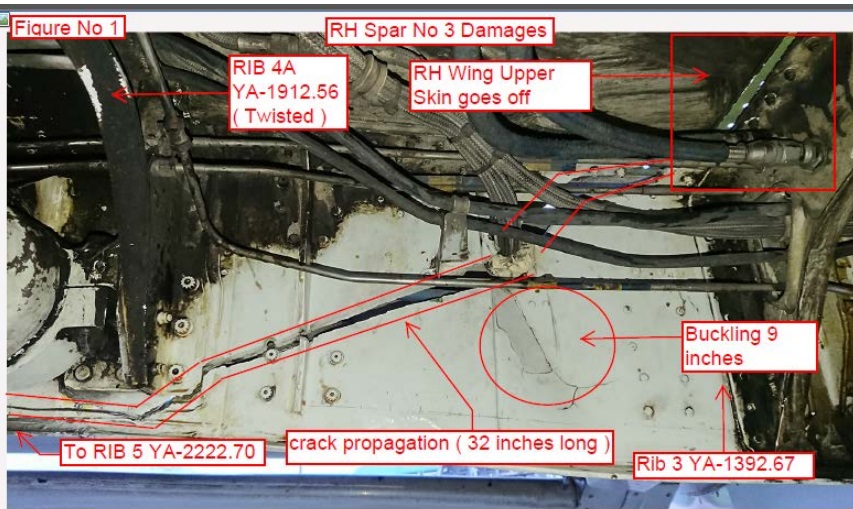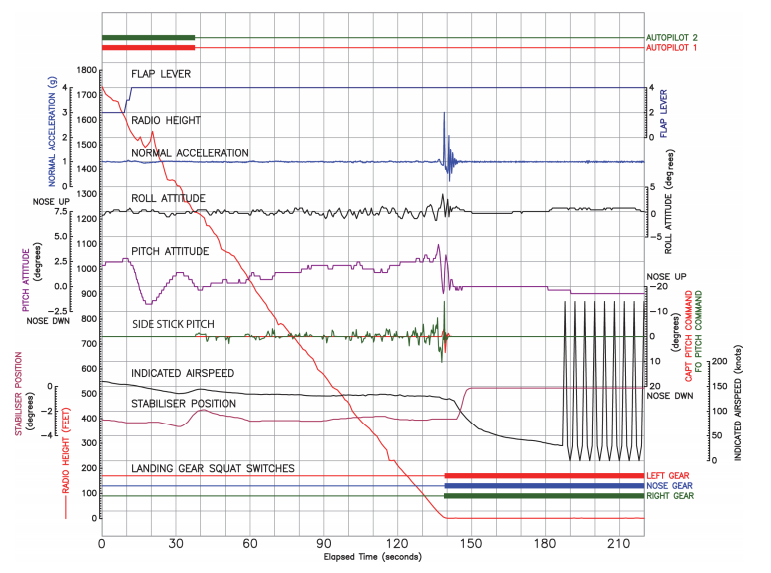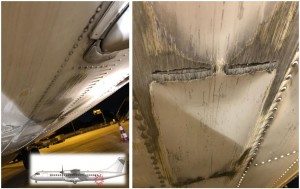Easyjet A319 G-EZAW Heavy Landing
The UK Air Accidents Investigation Branch (AAIB) have reported on a heavy landing involving Easyjet Airbus A319 G-EZAW at Munich Airport, 3 July 2017:
The aircraft was established on an ILS approach [but] at about 1,500 ft aal, the commander’s Flight Management Guidance Computer (FMGC)1 failed. The crew were unable to alter the target approach speed, and the engines began to spool up un-commanded. The pilot flying disconnected the autopilot and autothrust and the rest of the approach was flown manually.
Below 50 ft the pitch attitude of the aircraft was reduced slightly just before the aircraft was flared for landing, and it touched down heavily in a relatively flat attitude. The normal acceleration recorded at touchdown was 3.01 g [and 11.9 ft/sec], which is classified as a Severe Hard Landing.
The aircraft was inspected for a Severe Hard Landing as required by the manufacturer’s Aircraft Maintenance Manual. This inspection revealed damage to the nose landing gear and the right main landing gear as well as some cracking of the paint and sealant in the nose gear bay and avionics bay.
The landing gear was sent to an overhaul shop for inspection which…
…revealed that both the nose landing gear and the right main landing gear had suffered excessive loads during the landing and could not be returned to a serviceable condition. The nose landing gear shock-absorber cylinder was found buckled (below) with the barrel and forestay lower arm pin found to be out of tolerance.
Easyjet A319 G-EZAW nose landing gear (NLG) shock absorber cylinder after heavy landing at Munich (Credit: AAIB)
The right main landing gear sliding tube and shock-absorber were also found to be outside acceptable tolerances when measured.
AAIB Conclusions
…neither pilot realised that the aircraft was in the incorrect attitude for landing until it was too late to take corrective action.
It is possible that distractions and high workload during the approach contributed to the nose-down pitch input being made immediately before touchdown.
Other Safety Resources
A Germania A321-200 D-ASTP made a 3.32 g heavy landing Fuerteventura, in the Canary Islands on 16 July 2016. Unfortunately in that case:
Due to the absence of maintenance support at the Fuerteventura airport and, in the absence of a criterion on the meaning of landing report code ‘Hard’, the crew decided to make the return flight to Dusseldorf.
Consequently in their final report the CIAIAC (Investigación de accidentes e incidentes de aviación civil) recommend that Germania “improve the aptitude of its MOC personnel to ensure they provide correct support so that safe decisions are made in every aerodrome at all hours of operation”.
We discuss this in more detail here: A320 Flown on After Damaging Heavy Landing
UPDATE 14 April 2018: Air Mandalay Embraer ERJ-145 XY-ALE was damaged after a heavy landing during an unstabilised approach on 18 Sept 2017. the First Officer did a walkaround but did not spot the damage so the aircraft flew 2 more sectors before an engineer found the damage, according to the Aircraft Accident Investigation Bureau (AAIB) of Myanmar report.

Air Mandalay Embraer ERJ-145 XY-ALE No 3 Wing Spar Damage (Credit: Aircraft Accident Investigation Bureau of Myanmar)
UPDATE 2 May 2018: Flight Data Services discuss the analysis of hard landing FDM data.
UPDATE 11 July 2018: The TSB of Canada has released their report on the hard landing during wind shear of Jazz Aviation Bombardier Dash 8 Q400 C-GYJZ on 9 November 2017 which substantially damaged the aircraft and generated enough load to trigger the CVR/FDR crash switch. They report that the flight crew were unsure if this 5.7g touchdown was a hard landing or not. Rather than wait for maintenance personnel to travel to the airport the pilots therefore conducted a visual inspection of the aircraft and finding nothing abnormal, decided to operate the return flight, landing uneventfully back in Montreal. Subsequent maintenance inspection found:
…buckling of the skin below the windows on the right fuselage [and] the right main landing gear during the second touchdown exceeded its ultimate design criteria, which resulted in failure of the orifice support tube during the in-stroke. Once the orifice support tube failed, shock strut damping was effectively lost, thereby generating significant bottoming loads.
TSB comment:
Neither the aircraft manufacturer nor Jazz provide the flight crew with a definition of a hard landing or criteria to determine what a hard landing is. Pilots are expected to rely on their personal experience to make such a determination. In some cases, operational pressures may influence this assessment.
The operator’s safety actions reported were:
- providing additional training on how to recognize hard landings,
- strengthening and clarifying procedures and guidance associated with suspected or actual hard landings,
- adding a warning within flight crew guidance to inform crews of the risk of a hard landing if a landing is continued following a bounce with the power levers at flight idle or disc, and
- conducting a review of flight data analysis practices and effectiveness as they relate to preventing a departure when the aircraft’s airworthiness is concerned.
UPDATE 7 July 2019: Gripen Main Landing Gear Damaged During Unstabalised Short Field Landing
UPDATE 30 December 2019: White Air ATR-72-212A CS-DJG, operating for TAP Portugal, landed at Fez on 6 July 2018 after an unstabalised approach according to Portuguese accident investigators (the Gabinete de Prevenção e Investigação de Acidentes com Aeronaves [GPIAA]) but struck its tail onto the runway, touching down hard (+2.88G). The aircraft sustained abrasion damage to the aft fuselage, deformation between frames 35-38, sheared rivets and wear on the tail-skid.
The Aircraft Commander prepared for the return flight by performing a walk-round, carrying out a general inspection, looking for problems on the main landing gear and checking the tail strut (‘pogo stick’) fitted under the bumper when parked. He did not detect any anomalies and the aircraft was flown back to Lisbon before the damage was detected. GPIAA comment on:
….excessive reliance on aircraft acceptance without sharing and discussing with the operator’s technical services [and a] organizational culture with inadequate or nonexistent procedures and individual centered decision-making without effective implementation of the CRM philosophy.
Aerossurance is pleased to sponsor the 9th European Society of Air Safety Investigators (ESASI) Regional Seminar in Riga, Latvia 23 and 24 May 2018.





Recent Comments